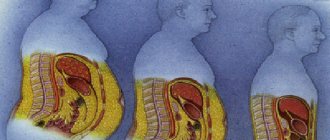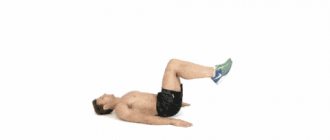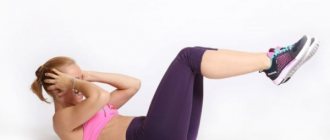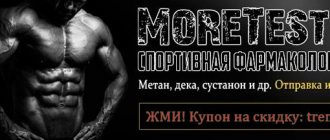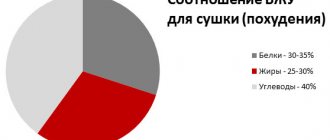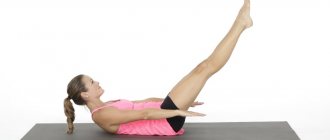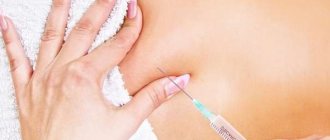Drying muscles at home is a completely understandable task, because the main condition for reducing body fat mass is nutrition - you need to eat fewer calories than you burn. In second place will be training, they will help guys quickly dry out the body of fat and make their muscles sculpted by increasing calorie consumption per day.
We have already told you what drying is and why it is needed, and in this article we will tell you how to properly dry for muscle relief for men at home or in the gym. Below you will find several training programs and choose the one that best suits your conditions and capabilities.
With the right diet, strength and frame training, you can lose up to 10 kg in 2 months, but this depends on the characteristics of the body, age, hormonal levels, lifestyle and nutrition.
The drying period can last up to 4 months, but it is better to do shorter cycles. As for training, of course, you can achieve results faster in the gym, but sports fans can get by with a well-chosen complex for terrain.
How to dry properly to improve muscle definition for men?
First, let's look at the general scheme, which is more competitive. Let me remind you that the term “cutting” comes from professional bodybuilding and is used to obtain muscle separation, that is, a complete absence of fat, in which muscle division is visible.
This form is not for life; maintaining such dryness for a long time leads to numerous destructive processes, ranging from muscle fibers to internal organs.
Therefore, before considering the drying scheme, I want to warn you that this is for professional athletes. Next, we’ll figure out how to reduce fat tissue without resorting to strict restrictions.
Diet
An athlete's daily diet should include:
- Proteins – 50-60%.
- Fats – 10-20%.
- Carbohydrates – 20%.
Such a diet leads to a sharp decrease not only in fat, but also in strength in general, because a deficiency of carbohydrates, as the main source of energy, leads to weakness, apathy, nervousness, and the like.
To lose weight more safely, but somewhat more slowly (after all, if you are not preparing for a competition, why make such sacrifices?), consider the following scheme.
- B – 50%.
- F – 20%.
- U – 30%.
A larger amount of carbohydrates (compared to the previous regimen) will burn subcutaneous fat more slowly, but safer.
To maintain muscle during a period of caloric deficit from carbohydrates, the body needs to provide an overdose of amino acids, that is, protein to preserve muscle mass. A deficiency of both carbohydrates and proteins will contribute to the burning of muscle tissue. Therefore, you should get used to the fact that there will be a lot of meat on such a diet!
Calculation of BZHU
A simple example for calculating BJU for a man weighing 80 kg:
- Proteins per day: 80 (weight) x 5 (protein, g per kilogram of weight) = 400 g of pure protein.
- Fat: 80 x 20 = 160 g pure fat.
- Carbohydrates: 80 x 30 = 240 g.
Next, you need to use the table of BZHU products and find out how much pure nutrient is in a particular product.
That is, 100 g of chicken fillet contains approximately 23 g of pure protein. And a person weighing 80 kg needs to eat 400 g of pure protein per day, which is almost 1.5 kg of chicken fillet.
Basic drying rules
- You need to start drying gradually. Any restrictions should not be introduced abruptly. Eating carbohydrates, which accounted for 60% of the total calories, switching to a low-carb diet is not only difficult, but also harmful. Before the start of drying, you should gradually, once a week, reduce the amount of carbohydrates by 10%, so by the start of drying their amount will decrease by 30%.
- Breaks between meals should be short. When drying, you need to eat small amounts every 2-3 hours. Long breaks even without the onset of hunger (which is hardly possible during drying) provoke catabolic processes, since protein cannot saturate and provide energy for a long time, so the body will take the lack of nutrients from its own muscles.
- Reduce the amount of salt, but don't eliminate it. The fact is that during drying, athletes refuse to use salt in order to achieve dry muscles, which is achieved by reducing the water level in the muscles, since salt can retain fluid. The abolition of salt threatens the loss of calcium and increased bone fragility. Such methods are unjustified if we talk about the form “for oneself” and not for the stage. Therefore, consume 1-2 grams of salt per day to maintain mineral and water-salt balance.
- Remove bad habits. Any alcoholic beverages and tobacco products are prohibited. Even the slightest stress leads the body, already susceptible to negative factors from the psyche, to nervous overstrain and exhaustion. Try not to be nervous, sleep more (at least 7 hours).
Next, we’ll take a closer look at what foods are allowed for drying (not competitive).
Rules for drying the body
- Having breakfast is a must! Skipping your morning meal slows down your metabolism.
- You need to eat frequently: 5 times a day, every 2-3 hours. Often, eating in fractional portions prevents the body from becoming “starved” and storing fats in reserve.
- The last meal is 2 hours before bedtime.
- 2/3 of the daily ration should be eaten in the first half of the day.
- Completely eliminate alcohol, sweets, fast food and sauces from your diet.
- Don't forget about water - you need to drink at least 2 liters of water a day!
- Take vitamins and multivitamin complexes , as a lack of certain vitamins can negatively affect muscles.
- The diet should contain healthy fats , which are found in fish or nuts.
Budget option for drying menu for a week for men
Of course, the drying period, when proteins predominate in the diet, is more financially expensive than nutrition for weight gain, in which cereals make up the majority of the menu. Here you have to eat not just proteins from protein shakes, cheeses, red fatty meats, any fish and other variety, but exclusively high-quality products with a minimum amount of fat. These include: chicken fillet, turkey, beef, veal, rabbit, lean fish, seafood, low-fat cottage cheese and egg whites.
Dry food itself cannot be cheap; as has already been said, it is necessary to consume proteins from quality products in large quantities. But you can make your diet as budget-friendly as possible by choosing the simplest and most affordable ingredients.
Monday
- Oatmeal with apples.
- Chicken fillet (breast), unpolished rice, cucumber.
- Unpolished rice, 4 egg whites + 2 yolks.
- Chicken fillet, fresh vegetables.
- Cottage cheese.
- Eggs, fresh vegetables (cabbage, cucumber, pepper, herbs).
Tuesday
- Oatmeal with banana.
- Cottage cheese with nuts (15 g).
- Baked hake, buckwheat or rice.
- Buckwheat, fish or chicken fillet, fresh vegetables.
- Fish baked with vegetables.
- Cottage cheese, eggs, kefir.
Wednesday
- Omelet, bread, dried fruits.
- Cottage cheese, apples or grapefruit.
- Rice, boiled chicken breast, salad.
- Chicken breast, salad, cottage cheese.
- Eggs, vegetables.
- Chicken breast, kefir.
Thursday
- Oatmeal, kefir, dried fruits.
- Salad, omelet with cottage cheese, buckwheat.
- Pollock baked with vegetables, rice.
- Fish, eggs, salad.
- Seafood salad.
- Cottage cheese, kefir.
Friday
- Oatmeal, fruit, kefir.
- Unpolished rice, chicken fillet.
- Rice or buckwheat, chicken fillet with vegetables.
- Meat or fish, baked vegetables.
- Salad with egg, vegetables and herbs, boiled squid.
- Squid with egg.
Saturday
- Omelette, kefir, bread with cheese.
- Rice, fruit, low-fat yogurt.
- Rice with vegetables, baked tuna (yellowtail).
- Tuna, salad.
- Mixed vegetables, chicken fillet.
- Eggs, kefir.
Sunday
- Oatmeal, dried fruits.
- Buckwheat, eggs, vegetables.
- Turkey, rice, baked vegetables.
- Cottage cheese, bread with cheese.
- Turkey or chicken.
- Squid and egg salad.
Only seven drying methods
- Fast race walking.
- Running at different distances.
- Cycling.
- Traveling on skis.
- Boxers jumping; jumping to the sides and in place.
- Squats.
- Squeezing the barbell with your legs.
The listed types of tasks will help both men and women to quickly get rid of fat accumulations on the lower extremities, provided:
Systematic exercise for twenty minutes a day and, without fail, proper nutrition. Burning fat cells without a well-designed diet is unrealistic. Diet and sport are one whole.
At home
To get rid of fat deposits, first of all, you need to put your nutrition at the proper level, choose the right special exercises, and high-intensity cardio training.
It is better to train your lower limbs at home using exercises based on using your own weight. These can be the following tasks:
- Simple squats. The number of approaches is three twenty-five times.
- Regular lunges. You need to do the movement at least twenty times.
- Cross lunge. You need to do it twenty times on one leg.
- Jump in place.
- Bends back.
- Move to the side.
- Lying down. Raising the lower limbs to the sides.
- Lying on your side. Leg lift.
Self-discipline, balanced nutrition, and exercise will make your legs beautiful and attractive.
Working out in the gym
To get positive results from training in the gym you need to:
- Perform activities on an elliptical trainer.
- Practice walking on the exercise ladder.
- Running on a treadmill using alternating speed of movements.
When working on the simulator, try to minimize the resistance and set the inclination angle lower so as not to end up with large muscle groups instead of thinner legs. It is advisable to work on the equipment four times a week for forty-five minutes.
Basic rules for working in the gym:
- You need to train after warming up.
- Monitor your pulse.
- Reduce calorie intake.
- Create your own training program.
Extended cutting nutrition program for men for a week
Monday
- Oatmeal with dried fruits.
- Chicken fillet (breast), brown rice, avocado.
- Rice, eggs or fish.
- Baked veal, fresh vegetables.
- Cottage cheese.
- Seafood, fresh vegetables (any).
Tuesday
- Whole grain bread with lightly salted pink salmon.
- Cottage cheese with dried fruits.
- Turkey meat, buckwheat or rice.
- Chicken or turkey fillet, vegetables.
- Pink salmon baked with vegetables.
- Cottage cheese, eggs, kefir.
Wednesday
- Omelette, whole grain bread with tofu.
- Cottage cheese and dried fruits.
- Rice, rabbit meat or beef.
- Chicken breast, vegetable salad.
- Seafood salad.
- Chicken breast, steamed vegetables.
Thursday
- Oatmeal and dried fruits.
- Salad with egg and squid, couscous.
- Tuna baked with vegetables, rice or bulgur.
- Fish or squid, baked vegetables.
- Salad with seafood or red fish.
- Cottage cheese, kefir.
Friday
- Chia seeds soaked in kefir with dried fruits.
- Unpolished rice, boiled beef.
- Buckwheat, chicken fillet with vegetables.
- Tuna or sea bass, baked vegetables.
- Salad with squid and chia seeds.
- Omelette with cottage cheese.
Saturday
- Omelette, bread with cheese, avocado.
- Tofu bread, fruit, low-fat yogurt.
- Rice with vegetables, baked tuna.
- Seafood salad, eggs.
- Mixed vegetables stewed with beef.
- Fish, stewed vegetables.
Sunday
- Oatmeal, dried fruits.
- Buckwheat, beef or veal.
- Turkey, rice, baked vegetables.
- Cottage cheese with bread and avocado.
- Turkey, salad.
- Seafood salad.
How to calculate daily calorie intake
The first thing you should do when starting a diet is to calculate your current daily calorie intake.
The amount of energy you consume each day determines your current body weight and body fat—this daily energy requirement is also called your “weight maintenance calorie level.”
Without making any changes to this indicator, you will not notice significant changes in your body. This is exactly the amount of energy you need every day to maintain your weight and stay in the same physical condition.
Ideally, you should aim to reduce your calorie intake by 20%—about 200 to 400 calories below your number. If you can achieve this, you will definitely see results in a couple of weeks.
Since no two people are the same, everyone has a different metabolic rate. These methods are just a rough guide for finding the right level - you'll have to do your own "experimentation" to determine the exact number.
But here are a few different ways to calculate calories. All you have to do is try each one and decide which suits you best...
Method #1 – Instinctive Approach
If your weight has remained the same for a while, then probably the easiest method for calculating calorie levels to maintain your weight without any complex calculations is the instinctive approach.
Provided you maintain the same weight over a long period of time , chances are you are burning as many calories as you consume.
This is great because all you have to do now is write down everything you eat and cut your calories accordingly. You can reduce your portion sizes or replace them with a lower-calorie, but filling option (you'll learn more about this later).
Method #2 – Formula 14 and 17
The 14 17 formula is a simple calculation you can do to determine your approximate calorie level for weight maintenance. This will give you an idea of how much you need to consume daily to reduce body fat.
You need to solve two equations:
- Your body weight (in kilograms) x 14 = A
- Your body weight (in kilograms) x 17 = B
Once you have found A and B, your calorie level for weight maintenance is somewhere between these numbers.
If you have a high metabolism, it will be at the high end of the resulting scale, and if you have a low metabolism, it will be at the lower end.
Take a look at your current calorie intake to see where you fall and what you need to do to reduce that number.
Method #3 – Mifflin-St. George Equation
This is by far one of the most complex methods for determining calorie levels for weight maintenance, but at the same time one of the most reliable: the Mifflin-St. George Equation.
Taking into account numerous factors such as:
- Age;
- Floor;
- Height;
- Weight;
- Level of physical activity.
The equation gives you an accurate estimate of how much you're consuming to maintain your current condition, and then all you have to do is subtract the amount of calories you can tolerate so you can continue exercising and let your body do the rest.
Once you know your daily calorie intake, remember it and try to reduce it gradually every day.
What to do after hard drying for men
Once you’ve finished drying, you shouldn’t suddenly quit your diet and jump on everything at once. You should also remember that all efforts are not in vain, it is better to maintain the result. Otherwise, a sudden departure from the diet threatens severe swelling and rapid accumulation of subcutaneous fat. Therefore, gradually return previously prohibited foods to the menu - dairy products, pasta, starchy vegetables and cereals. But not all at once, but alternating. For example, once every few days: on Monday you can add pasta, and on Thursday - fatty meat or potatoes, and so on.
Weekly program for drying the male body
| Day of the week | Exercises for drying the body |
| Monday and Friday | Hack squats superset with deadlifts. Dumbbell bench press in a superset with a vertical block row. Barbell curls in a superset with a similar exercise, but with an underhand grip. Donkey exercise (calf training). Seated calf raise (exercise for soleus muscles). |
| Wednesday | Hyperextension. Raises of arms with dumbbells, standing straight (training the lateral heads of the deltas). Raising your arm in front of you (training the front deltoids). Arm raises while standing bent over (exercise for the rear deltas). Lifting the barbell for biceps in a superset with arm extensions. |
Squats and deadlifts will keep your abs in shape. In other cases, abdominal training is necessary. On Monday and Friday, abdominal training should be gentle; 5 sets of classic crunches will be enough. Nothing more serious will happen - insofar as the abdominal muscles are already noticeably tired in squats and deadlifts.
Contraindications
Drying the body for men is a great way to transform your body, adding sculpted muscles to it. However, this diet is not suitable for everyone.
It is contraindicated for people to go on a sports diet:
- with kidney diseases;
- with stomach diseases;
- with pancreatic diseases;
- with intestinal diseases;
- with liver diseases;
- suffering from diabetes;
- subject to individual restrictions.
Important! Before drying, be sure to consult your doctor.
BZHU during the drying period
On the day of training, carbohydrates should be present in the athlete's diet. But these, as already mentioned, must be complex carbohydrates.
Complex (also called complex) carbohydrates are black bread, cereals, pasta and fruits and vegetables. Sweets (i.e., simple carbohydrates) can be consumed by ectomorphic athletes, but in small quantities, and in no case should they be consumed before training. After training, eating sweet foods is acceptable - insofar as during this period the body needs glucose. The second meal after training should consist of complex carbohydrates with a small amount of protein. Let's calculate the required amount of carbohydrates, proteins and fats.
For example, let's assume that your body weight is 85 kg. Proteins - 2 g per 1 kg of body weight (85 x 2 = 170 g).
It is advisable to consume proteins throughout the day in equal portions of about 30 g, but if there is more in some portion, it’s okay: proteins take quite a long time to digest.
Carbohydrates - from 2 to 7 g per 1 kg of body weight for normal nutrition, when cutting we reduce it to a minimum - 2 g (85 x 2 = 170 g)
Fats - they are definitely needed, the golden rule is 0.5 g per 1 kg of body (85 x 0.5 = 42.5 g of fat per day)
The number of calories (of course, we are talking about kilocalories, Kcal) is calculated based on the amount of proteins, carbohydrates, fats:
· Carbohydrates – 4 Kcal/g,
· Proteins – 4 Kcal/g,
· Fats – 9 Kcal/g.
Example: for our diet, the number of calories (we take carbohydrates to the maximum) is as follows: 170*4+170*4+42.5*9 = 1742.5 Kcal
Popular articles for weight loss and health
Strict diet for quick weight loss
Chemical diet for 4 weeks menu
Recipes for Great Lent in 2020 for every day
Quick weight loss of 10 kg in a week at home
Useful products for drying
A diet for drying the body for men should be balanced in vitamin and mineral composition. This is important for the smooth functioning of the body and maintaining muscle tone. Therefore, it is necessary to include the following healthy foods in your diet:
- lean meat: chicken, turkey, beef;
- fish: salmon, salmon, trout;
- eggs;
- kefir and cottage cheese;
- mushrooms;
- cereals;
- pasta made from durum flour;
- legumes;
- radish, zucchini;
- fresh vegetables;
- vegetable oils;
- fruits;
- mineral water;
- green tea.
On a note! 250 g of rice contains 200 g of complex carbohydrates. The same amount of buckwheat contains approximately 167 g of complex carbohydrates.
Important! During drying, you should not eat foods that retain fluid in the tissues: flour products, coffee, grapes, alcohol, salt, sugar.
Drying preparations containing fat and carbohydrate blockers
Cutting preparations containing fat and carbohydrate blockers are quite popular, as some believe that thanks to them, you can lose weight without reducing your caloric intake or exercising. Their use will be effective before various events, banquets, where there is a risk of consuming excessive amounts of fatty, heavy foods.
Fat blockers are divided into substances that bind fat molecules and those that stop the production of enzymes that ensure the breakdown of fats.
The binding of fat molecules occurs according to the principle of adsorption. The substance chitosan is added to sports preparations for drying the body, which also has a detoxification effect.
If there is a need to block lipase, you can use a drug called Xenical, which acts exclusively in the gastrointestinal tract and is not toxic. Reduces the number of calories consumed.
Despite the positive aspects, the drug has side effects, including bloating, diarrhea, and increased gas formation. Tablets for drying the body, containing carbohydrate blockers, reduce the body's production of the enzyme that breaks down starch - amylase. The downside is that the absorption of complex carbohydrates, which are extremely necessary for the human body, is blocked.
Be sure to read: The main pros and cons of drinking protein shakes for weight loss
Side effects from these drugs are: heaviness in the gastrointestinal tract, diarrhea.
L-carnitine
L-carnitine is by far one of the safest supplements for accelerating the fat burning process. It is an amino acid-like substance produced by the human body when consuming protein.
An important rule in using this drug for drying is to increase physical activity, increasing the pulse by 60% of the standard. This includes long, fast walking uphill, running, dancing, cycling, any type of aerobics, etc.
The next very important point is that to achieve the effect of L-carnitine, training should last at least half an hour. It is recommended to take the drug in parts: 300 mg before training, the remaining dose no earlier than 15 minutes after training.
The correct diet when using the drug for drying the body would be 5 – 6 doses. A few hours before training, it would be best to consume a portion of pure protein: cottage cheese, fish. An hour after training, you can drink a protein shake.
Experts strongly recommend using this drug together with BCAA (a bunch of amino acids isoleucine, leucine, valine), which restores damaged muscle tissue, allowing you to keep it in good shape. By following these rules, L-carnitine will have a clear effect in the process of losing weight and reducing fat mass, increasing endurance, adding energy, and lowering cholesterol levels.
Metmorphine
Another pharmaceutical drug for drying the body is metmorphine, which helps in the process of weight loss. The advantage of the substance is the almost complete absence of side effects. If the dosages are calculated correctly, it does not pose a danger to human health.
In addition, the drug reduces cholesterol and glucose levels. The mechanism of action is to accelerate the oxidation of fatty acids and inhibit the synthesis of fats. When using metmorphine, side effects are insignificant and are quite rare, including diarrhea and nausea. It is important to know that long-term use suppresses the production of insulin by the pancreas.
